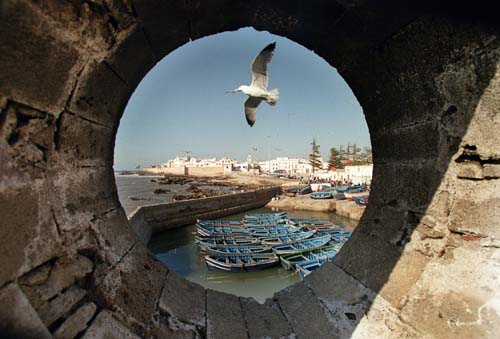An article entitled Authentic Morocco by Jonathan Gregson writing for the Financial Times is a much better crafted piece than much of the gushingly Orientalist fare served up by the tabloids. Here is a short extract.
If what you seek in Morocco is sunshine with all the usual international trimmings - designer interiors, capacious swimming pools, a choice of spa treatments and/or golf courses - all served up with just a twist of Old Araby, then follow the herd and head for Marrakech. Massive infusions of mainly Gulf money are transforming its surrounding palmeraie into a Palm Springs-style playground in the sun, while the old town is now studded with estate agents quoting prices in euros rather than dirhams.
If, however, you want to be transported into a completely different world, then go to Fez. It's not just that it is the oldest of Morocco's four imperial cities (the others being Meknes, Rabat and Marrakech) and is this year celebrating its 1,200th anniversary; nor even that the entire Medina has been awarded Unesco World Heritage status. Rather it is because when it comes to such intangibles as dignity, refinement and sheer authenticity, Fez wins hands down.
That may be because Fez el Bali (Old Fez) remains a fully functioning medieval city, a hive of industry whose products - be they filigree work or bridal thrones - are as much in demand among local buyers as foreigners. On weekends, its succession of souks (which on first acquaintance resemble a medieval department store) are crammed with Berber villagers and more sophisticated visitors from Casablanca or Rabat, all seeking wedding presents or hand-crafted furnishings for their own homes.
The pride that Fassis (the people of Fez) take in their craftmanship and industry - many of the skills came with refugees from Andalucia fleeing the Reconquistá - may account for a certain hauteur. It also makes this city feel quite distinct from most other picturesque relics of a bygone age, whose economic survival depends on tourism and whose residual population is there to "service" the visitor.
Some find such un-Disneyfied authenticity frightening. It certainly came as a shock on my first visit some 30 years back. I was no novice, having already been through Marrakech, the High Atlas and the southern oases; but nothing had prepared me for the unique combination of timelessness and big-city intensity I found in Fez. I felt like an Oklahoma boy just arrived in Manhattan, overwhelmed by the crush of humanity and their hurried big-city ways.
For crowded within the city's 13th-century walls are religious scholars and merchants, wool carders and dyers, tanners, silk weavers, slipper makers, woodcarvers, silversmiths and brass-workers, porters, barrow boys, muleteers and donkey-men. These last because the streets and alleyways of Fez el Bali are so steep and so narrow that no motor vehicle can enter.
Everything that is consumed or produced within the city must be carried by man or beast. "There are 10,000 donkeys," I was informed, "and that is if you count only the four-legged ones." So, while walking around the Medina, it is best to keep an ear open for the cries of " Balak! Balak!" that announce the arrival of a donkey-train just in time for pedestrians to take evasive action. Also, to follow the Fassi custom of skirting the sides of thoroughfares (like British motorists, they keep to the left) so as to avoid being bumped by the passing animal's load - which could be anything from a new refrigerator to uncured hides.
While there are a few main arteries through the Old City, such as the Grand Tala ("our own Champs Elysées"), most of the alleyways twist and turn so much that you are certain to get lost sooner or later unless you have a guide. Not that I find this an altogether unpleasant sensation. By wandering aimlessly I discovered a traditional apothecary whose glass cabinets contained all manner of marvellous cures, from powdered herbs and minerals to desiccated lizard. On my last visit I turned down a covered alley to find myself following what seemed to be an endless silken thread, as though on Ariadne's trail. At the end of it was a moustachioed weaver, juggling with two spools, who had seen fit to use this public byway as his workshop.
Here is a link to the full article: Authentic Morocco
Check out our earlier travel writing stories:
Travel Writing Twenty-one
Travel Writing Twenty
Travel Writing Nineteen
Travel Writing Eighteen
Travel Writing Seventeen
Travel writing Sixteen.
Travel Writing Fifteen.
Travel Writing Fourteen.
Travel Writing Thirteen.
Travel Writing Twelve.
Travel Writing Eleven.
Travel Writing Ten.
Travel Writing Nine
Travel writing eight
Travel writing Seven
Travel Writing Six
Travel Writing Five
Travel Writing Four
Travel Writing Three
Travel Writing Two
Travel Writing One
Tags: Moroccan Morocco Fes, Maghreb news

